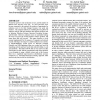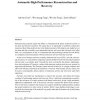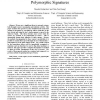122 search results - page 9 / 25 » Re-wiring Activity of Malicious Networks |
IMC
2009
ACM
14 years 5 months ago
2009
ACM
Fast-flux is a redirection technique used by cyber-criminals to hide the actual location of malicious servers. Its purpose is to evade identification and prevent or, at least de...
ACMSE
2006
ACM
14 years 26 days ago
2006
ACM
Society has grown to rely on Internet services, and the number of Internet users increases every day. As more and more users become connected to the network, the window of opportu...
CN
2007
13 years 11 months ago
2007
Self-protecting systems require the ability to instantaneously detect malicious activity at run-time and prevent execution. We argue that it is impossible to perfectly self-protec...
CORR
2008
Springer
13 years 11 months ago
2008
Springer
: Network intrusion detection systems are themselves becoming targets of attackers. Alert flood attacks may be used to conceal malicious activity by hiding it among a deluge of fa...
ICCCN
2007
IEEE
14 years 5 months ago
2007
IEEE
—Worms are a significant threat to network systems, both through resource consumption and malicious activity. This paper examines the spread of a class of hitlist-based worms tha...



